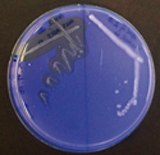Chitin is the second most abundant biopolymer on earth after cellulose. It is used, for example, in tanks of crustaceans and insects as a scaffolding substance and is therefore produced in large quantities as waste in aquaculture and fisheries. Chitin can be broken down by many bacteria by chitinases. The linear, insoluble homopolymer of beta-1,4-linked N-acetyl glucosamine units (NAG) is split into oligo- or monomers.
At Fraunhofer IGB we are developing an enzymatic process in which chitin is degraded to monomers. These can then be hydrothermally converted into easily modifiable basic building blocks of biobased polymers. In a first step, we used enrichment cultures to search for organisms that produce new chitinases that are not yet protected by patents.
Laboratory experiments with the isolates have shown that the production of chitinases is growth-coupled and the enzymes are secreted into the culture medium. The enzyme cocktail is first produced in a two-stage process and then used to generate chitin sales after separation of the biomass. In this way, we have succeeded in completely converting a 1 percent chitin suspension into NAG.
Enzymatic conversion of chitin
Identification of new chitinase producers

Chitinolytic bacteria on agar plates.
In order to be able to describe the chitinases on a molecular level and at the same time create the prerequisite for recombinant expression, we have also produced gene libraries of the isolates in E. coli. We have already identified several new chitinases using genomic walking and expression-assisted screening. Next Generation Sequencing (NGS) was also used to sequence the genomes of two isolates to enable precise identification of the strains and to search in silico for chitin-degrading enzymes. Thus, a set of four or eleven different enzymes could be identified, which catalyze the degradation of chitin as a secreted cocktail. The identified gene sequences of the chitinases can now be used for recombinant expression.
Range of services
We can offer you the following services:
- Screening and recombinant expression of chitinases, chitin deacetylases
- Investigation of new chitin sources for the synthesis of N-acetyl-glucosamine and glucosamine
- Genome sequencing of chitinolytic microorganisms
 Fraunhofer Institute for Interfacial Engineering and Biotechnology IGB
Fraunhofer Institute for Interfacial Engineering and Biotechnology IGB